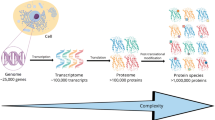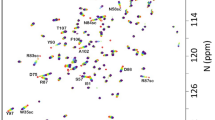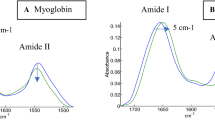Abstract
Protein methyl groups have recently been the subject of much attention in NMR spectroscopy because of the opportunities that they provide to obtain information about the structure and dynamics of proteins and protein complexes. With the advent of selective labeling schemes, methyl groups are particularly interesting in the context of chemical shift based protein structure determination, an approach that to date has exploited primarily the mapping between protein structures and backbone chemical shifts. In order to extend the scope of chemical shifts for structure determination, we present here the CH3Shift method of performing structure-based predictions of methyl chemical shifts. The terms considered in the predictions take account of ring current, magnetic anisotropy, electric field, rotameric type, and dihedral angle effects, which are considered in conjunction with polynomial functions of interatomic distances. We show that the CH3Shift method achieves an accuracy in the predictions that ranges from 0.133 to 0.198 ppm for 1H chemical shifts for Ala, Thr, Val, Leu and Ile methyl groups. We illustrate the use of the method by assessing the accuracy of side-chain structures in structural ensembles representing the dynamics of proteins.









Similar content being viewed by others
References
Abraham R, Canton M, Griffiths L (2001) Proton chemical shifts in nmr: Part 17. Chemical shifts in alkenes and anisotropic and steric effects of the double bond. Magn Reson Chem 39:421–431
Agarwal V, Xue Y, Reif B, Skrynnikov NR (2008) Protein side-chain dynamics as observed by solution- and solid-state nmr spectroscopy: a similarity revealed. J Am Chem Soc 130:16611–16621
Baldwin AG, Religa TL, Hansen DF, Bouvignies G, Kay LE (2010) 13chd2 methyl group probes of millisecond time scale exchange in proteins by 1h relaxation dispersion: an application to proteasome gating residue dynamics. J Am Chem Soc 132:10992–10995
Berman HM, Westbrook J, Feng Z, Gilliland G, Bhat TN, Weissig H, Shindyalov IN, Bourne PE (2000) The protein data bank. Nucl Acids Res 28:235–242
Buckingham AD (1960) Chemical shifts in the nuclear magnetic resonance spectra of molecules containing polar groups. Can J Chem 38:300–307
Buckingham AD, Pople JA (1963) High-resolution n.m.r. spectra in electric fields. Trans Faraday Soc 59:2421–2430
Case DA (1995) Calibration of ring-current effects in proteins and nucleic acids. J Biomol NMR 6:341–346
Cavalli A, Salvatella X, Dobson CM, Vendruscolo M (2007) Protein structure determination from nmr chemical shifts. Proc Natl Acad Sci USA 104:9615–9620
Cornilescu G, Marquardt JL, Ottiger M, Bax A (1998) Validation of protein structure from anisotropic carbonyl chemical shifts in a dilute liquid crystalline phase. J Am Chem Soc 120:6836–6837
Das R, Andre I, Shen Y, Wu YB, Lemak A, Bansal S, Arrowsmith CH, Szyperski T, Baker D (2009) A transient and low-populated protein-folding intermediate at atomic resolution. Proc Natl Acad Sci USA 106:18978–18983
DeGortari I, Portella G, Salvatella X, Bajaj VS, van der Wel PS, Yates JR, Segall MD, Pickard CJ, Payne MC, Vendruscolo M (2010) Time averaging of nmr chemical shifts in the mlf peptide in the solid state. J Am Chem Soc 132:5993–6000
DeSimone A, Cavalli A, Hsu STD, Vranken W, Vendruscolo M (2009) Accurate random coil chemical shifts from an analysis of loop regions in native states of proteins. J Am Chem Soc 131:16332–16333
Duan Y, Wu C, Chowdhury S, Lee MC, Xiong G, Zhang W, Yang R, Cieplak P, Luo R, Lee T, Caldwell J, Wang J, Kollman P (2003) A point-charge force feld for molecular mechanics simulations of proteins based on condensed-phase quantum mechanical calculations. J Comput Chem 24:1999–2012
Fares C, Lakomek NA, Walter KFA, Frank BTC, Meiler J, Becker S, Griesinger C (2009) Accessing ns-μs side chain dynamics in ubiquitin with methyl rdcs. J Biomol NMR 45:23–44
Gelis I, Bonvin AM, Keramisanou D, Koukaki M, Gouridis G, Karamanou S, Economou A, Kalodimos CG (2007) Structural basis for signal-sequence recognition by the translocase motor seca as determined by nmr. Cell 131:756–769
Goto NK, Kay LE (2000) New developments in isotope labeling strategies for protein solution nmr spectroscopy. Curr Opin Struct Biol 10:585–592
Haigh CW, Mallion RB (1972) New tables of ring current shielding in proton magnetic resonance. Org Magn Reson 4:203–228
Haigh CW, Mallion RB (1980) Ring current theories in nuclear magnetic resonance. Prog NMR Spectrosc 13:303–344
Hansen DF, Neudecker P, Vallurupalli P, Mulder FAA, Kay LE (2010) Determination of leu side-chain conformations in excited protein states by nmr relaxation dispersion. J Am Chem Soc 132:42–43
Hong M, Mishanina TV, Cady SD (2009) Accurate measurement of methyl 13c chemical shifts by solid-state nmr for the determination of protein side chain conformation: the influenza a m2 transmembrane peptide as an example. J Am Chem Soc 131:7806–7816
Hsu STD, Cabrita LD, Fucini P, Christodoulou J, Dobson CM (2009) Probing side-chain dynamics of a ribosome-bound nascent chain using methyl nmr spectroscopy. J Am Chem Soc 131:8366–8367
Jameson CJ (1996) Understanding nmr chemical shifts. Annu Rev Phys Chem 47:135–169
Jensen MR, Salmon L, Nodet G, Blackledge M (2010) Defining conformational ensembles of intrinsically disordered and partially folded proteins directly from chemical shifts. J Am Chem Soc 132:1270–1272
Kainosho M, Torizawa T, Iwashita Y, Terauchi T, Mei MO, Guntert P (2006) Optimal isotope labeling for nmr protein structure determinations. Nature 440:52–57
Kohlhoff KJ, Robustelli P, Cavalli A, Salvatella X, Vendruscolo M (2009) Fast and accurate predictions of protein nmr chemical shifts from interatomic distances. J Am Chem Soc 131:13894–13895
Korzhnev DM, Religa TL, Banachewicz W, Fersht AR, Kay LE (2010) A transient and low-populated protein-folding intermediate at atomic resolution. Science 329:1312–1316
Lange OF, Lakomek NA, Fares C, Schroder GF, Walter KFA, Becker S, Meiler J, Grubmuller H, Griesinger C, de Groot BL (2008) Recognition dynamics up to microseconds revealed from an rdc-derived ubiquitin ensemble in solution. Science 320:1471–1475
Lehtivarjo J, Hassinen T, Korhonen SP, Perakyala M, Laatikainen R (2009) 4d prediction of protein 1h chemical shifts. J Biomol NMR 45:413–426
Lindorff-Larsen K, Piana S, Palmo K, Maragakis P, Klepeis JL, Dror RO, Shaw DE (2010) Improved side-chain torsion potentials for the amber ff99sb protein force field. Proteins 78:1950–1958
London RE, Wingad BD, Mueller GA (2008) Dependence of amino acid side chain 13c shifts on dihedral angle: application to conformational analysis. J Am Chem Soc 130:11097–11105
McConnell HM (1957) Theory of nuclear magnetic shielding in molecules. 1. long-range dipolar shielding of protons. J Chem Phys 27:226–229
Meiler J (2003) Proshift: protein chemical shift prediction using artificial neural networks. J Biomol NMR 26:25–37
Montalvao R, Cavalli A, Salvatella X, Blundell TL, Vendruscolo M (2008) Structure determination of protein-protein complexes using nmr chemical shifts: the case of an endonuclease colicin—immunity protein complex. J Am Chem Soc 130:15990–15996
Mulder FAA (2009) Leucine side-chain conformation and dynamics in proteins from 13c nmr chemical shifts. Chem Bio Chem 10:1477–1479
Neal S, Nip AM, Zhang H, Wishart DS (2003) Rapid and accurate calculation of protein 1h, 13c and 15n chemical shifts. J Biomol NMR 26:215–240
Oldfield E (1995) Chemical shifts and 3-dimensional protein structures. J Biomol NMR 5:217–225
Ösapay K, Case DA (1991) A new analysis of proton chemical shifts in proteins. J Am Chem Soc 113:9436–9444
Otten R, Chu B, Krewulak KD, Vogel HJ, Mulder FA (2010) Comprehensive and cost-effective nmr spectroscopy of methyl groups in large proteins. J Am Chem Soc 132:2952–2960
Pearson JG, Le H, Sanders LK, Godbout N, Havlin RH, Oldfield E (1997) Predicted chemical shifts in proteins: structure refinement of valine residues by using ab initio and empirical geometry optimizations. J Am Chem Soc 119:11941–11950
Raman S, Lange OF, Rossi P, Tyka M, Wang X, Aramini J, Liu G, Ramelot TA, Eletsky A, Szyperski T, Kennedy MA, Prestegard J, Montelione GT, Baker D (2010) Nmr structure determination for larger proteins using backbone-only data. Science 327:1014–1018
Reif B, Xue Y, Agarwal V, Pavlova MS, Hologne M, Diehl A, Ryabov YE, Skrynnikov NR (2006) Protein side-chain dynamics observed by solution- and solid-state nmr: comparative analysis of methyl 2h relaxation data. J Am Chem Soc 128:12354–12355
Richter B, Gsponer J, Varnail P, Salvatella X, Vendruscolo M (2007) The mumo (minimal under-restraining minimal over-restraining) method for the determination of native state ensembles of proteins. J Biomol NMR 37:117–135
Rieping W, Vranken WF (2010) Validation of archived chemical shifts through atomic coordinates (vasco). Proteins 78:2482–2489
Robustelli P, Cavalli A, Vendruscolo M (2008) Determination of protein structures from solid-state nmr chemical shifts. Structure 16:1764–1769
Robustelli P, Kohlhoff K, Cavalli A, Vendruscolo M (2010) Using nmr chemical shifts as structural restraints in molecular dynamics simulations of proteins. Structure 18:923–933
Ruschak A, Kay LE (2010) Methyl groups as probes of supra-molecular structure, dynamics and function. J Biomol NMR 46:75–87
Shen Y et al (2008) Consistent blind protein structure generation from nmr chemical shift data. Proc Natl Acad Sci USA 105:4685–4690
Shen Y, Bax A (2007) Protein backbone chemical shifts predicted from searching a database for torsion angle and sequence homology. J Biomol NMR 38:289–302
Shen Y, Vernon R, Baker D, Bax A (2009) De novo protein structure generation from incomplete chemical shift assignments. J Biomol NMR 43:63–78
Sheppard D, Guo C, Tugarinov V (2009) 4d 1h - 13c nmr spectroscopy for assignments of alanine methyls in large and complex protein structures. J Am Chem Soc 131:1364–1365
Sheppard D, Sprangers R, Tugarinov V (2010) Experimental approaches for nmr studies of side-chain dynamics in high-molecular-weight proteins. Prog NMR Spectrosc 56:1–45
Sprangers R, Kay L (2007) Quantitative dynamics and binding studies of the 20s proteasome by nmr. Nature 445:618–622
Tugarinov V, Ollerenshaw JE, Kay LE (2005) Probing side chain dynamics in high molecular weight proteins by deuterium nmr spin relaxation: an application to an 82-kda enzyme. J Am Chem Soc 127:8214–8225
Tugarinov V, Kanelis V, Kay LE (2006) Isotope labeling strategies for the study of high-molecular-weight proteins by solution nmr spectroscopy. Nat Protoc 1:749–754
Ulrich EL (2007) Biomagresbank. Nucl Acids Res 36:D402–D408
Vijay-Kumar S, Bugg CE, Cook WJ (1987) Structure of ubiquitin refined at 1.8 å resolution. J Mol Biol 194:531–544
Vila JA, Scheraga HR (2009) Assessing the accuracy of protein structures by quantum mechanical computations of 13c(alpha) chemical shifts. Acc Chem Res 42:1545–1553
Vranken WF, Rieping W (2009) Realtionship between chemical shift value and accessible surface area for all amino acid atoms. BMC Struc Biol 9:20
Vranken WF, Boucher W, Stevens TJ, Fogh RH, Pajon A, Llinas M, Ulrich EL, Markley JL, Ionides J, Laue ED (2005) The ccpn data model for nmr spectroscopy: development of a software pipeline. Proteins 59:687–696
Wang G, Dunbrack RL (2003) Pisces: a protein sequence culling server. Bioinformatics 19:1589–1591
Wishart DS (2011) Interpreting protein chemical shift data. Prog Nucl Magn Reson Spectrosc 58:62–87
Wishart DS, Watson MS, Boyko RF, Sykes BD (1997) Automated h-1 and c-13 chemical shift prediction using biomagresbank. J Biomol NMR 10:329–336
Xu XP, Case DA (2001) Automated prediction of 15n, 13cα, 13cβ and 13c′ chemical shifts in proteins using a density functional database. J Biomol NMR 21:321–333
Xu Y, Liu M, Simpson PJ, Isaacson R, Cota E, Marchant J, Yang D, Zhang X, Freemont P, Matthews S (2009) Automated assignment in selectively methyl-labeled proteins. J Am Chem Soc 131:9480–9481
Acknowledgments
A.B.S. thanks Herchel Smith Foundation for the generous support. M.V. acknowledges the funding from the Leverhulme Trust, EMBO, the Royal Society and the BBSRC. W.F.V. was supported by the EU FP7 e-NMR grant 213010.
Author information
Authors and Affiliations
Corresponding author
Electronic supplementary material
Below is the link to the electronic supplementary material.
Rights and permissions
About this article
Cite this article
Sahakyan, A.B., Vranken, W.F., Cavalli, A. et al. Structure-based prediction of methyl chemical shifts in proteins. J Biomol NMR 50, 331–346 (2011). https://doi.org/10.1007/s10858-011-9524-2
Received:
Accepted:
Published:
Issue Date:
DOI: https://doi.org/10.1007/s10858-011-9524-2




